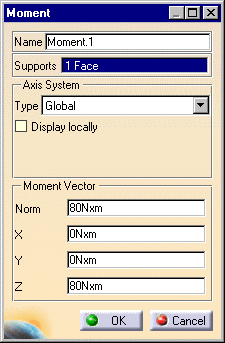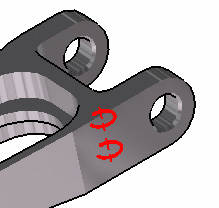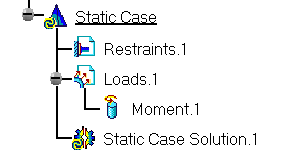 |
Moments
are
force systems statically equivalent to a given pure couple
(single
moment resultant), distributed on a virtual part or on a geometric selection.
Moment objects belong to Loads objects sets.The user specifies three
components for the direction of the resultant moment, along with a magnitude information. Upon modification of any of these four
values, the resultant moment vector components and magnitude are updated
based on the last data entry. The resultant moment vector remains constant
independently of the geometry selection.
The given pure couple system is processed by the program as follows:
 | In the case of extended geometries, it is transformed into an
equivalent force system distributed over the selected support. |
 | In the case of virtual parts connected to deformable bodies, it is
transmitted as a force system collectively to the entire connected
geometry. |
The point of application of the couple is arbitrary.
Units are moment units (typically Nm
in SI).
|
 |
Moments can be applied to the following types of Supports:

|
 |
This task shows you how to
create a Moment applied to a virtual part or to a geometry
selection.
|
 |
You can use the sample00.CATAnalysis
document from the samples directory
for this task:
Finite Element Model containing a Static Analysis Case and computed corresponding Static
Solution.
Before You Begin:
Go to View -> Render Style -> Customize View and make
sure the Shading, Outlines and Materials options are active in the Custom View Modes
dialog box.
|
 |
1. Click the Moment icon  . .
The Moment dialog box is displayed.

2. You can change the identifier of the Moment by editing the
Name field.
The Axis System Type combo box allows you to
choose between Global and User Axis systems, for entering
components of the resultant moment vector.
 | Global: if you select the Global Axis system, the components of the
resultant moment vector will be interpreted as relative to the fixed
global rectangular coordinate system. |
 | User: if you select a User-defined Axis system, the
components of the resultant moment vector will be interpreted as
relative to the specified rectangular coordinate system. |
To select a User Axis System, you must activate an existing
Axis by clicking it in the specification tree. Its name will then be
automatically displayed in the Current Axis field.
3. Set the Axis system.
|
 |
 | You can define the resultant moment
vector direction by using the compass. |
 | You can modify the compass
orientation either with the mouse or by editing the compass. |
 | By applying the compass to any
part geometry, you can align the compass directions with the implicit axis
directions of that geometry: drag the compass by handling the red square
and drop it on the appropriate surface. The normal direction to this
surface defines the new direction. Then, click on the Compass Direction
button to take this new direction into account. You can now invert the
direction if desired, editing the values of the three components. |
4. Enter values for the X, Y, Z
components of the resultant moment vector: the corresponding Norm
value is automatically computed and displayed.

5. Select the support (a
virtual part or a geometry) on which the resultant moment vector is
applied. Any selectable geometry is
highlighted when you pass the cursor over it.
You can select several supports in
sequence, to apply the Moment to all supports
simultaneously.
A symbol representing the resultant moment equivalent to the
Moment is displayed at the application point of the support to visualize
the input force system.

6. Enter a new value for any one of the four fields of the resultant
moment.
The remaining three
fields are automatically computed and displayed.
The visualized symbols orientation is also updated to reflect the
modification.
7. Click OK in the Moment dialog box to
create the Moment.
A Moment object appears in the specification tree under the active
Loads objects set.

|
|

|
 | You can either select the
support and then set the Moment specifications, or set the Moment specifications and then select the
support. |
 | If you select several geometric
supports,
you can create as many Moment loads as desired with the
same dialog box. A series of Moments can therefore be
created quickly. |
 |
Loads are required for Stress
Analysis computations. |
 | If several Analysis Cases have been defined in
the Finite Element Model, you must activate a Loads objects set in the
specification tree before creating a Moment object (only
available if you have ELFINI Structural Analysis product
installed). |
 | Moment objects can be edited by a double click on the
corresponding object or icon in the specification tree. |
|
 |
Make sure the computation is finished before
starting any of the following operations. |
|

|
Products
Available in
Analysis Workbench
The ELFINI Structural Analysis
product offers the following additional features with a right mouse click
(key 3):
 |  on a Moment object:
on a Moment object:
Moment Visualization on Mesh: the translation of your Moment object specifications into solver specifications
can be visualized symbolically at the impacted mesh nodes, provided
the mesh has been previously generated via a Compute action. |
 |  on a Loads objects set:
on a Loads objects set:
1) Generate Image: generates an image of the computed Load objects
(along with translating all user-defined Loads specs into explicit solver commands
on mesh entities), by
generating symbols for the elementary loads imposed by the Loads
objects set. The image can be edited to include part or all of the
options available.
2) Report: the partial status and results of intermediate
pre-processor computations are reported in HTML format. It represents
a subset of the global Report capability and generates a partial
report of the Loads objects set Computation.
See Creating Pressures for more details.
|
|
|
3) Double-clicking on the Loads set, you will display the
Loads dialog box that lets you choose whether you wish to apply
self-balancing to the load. Example of use: if this option is used with
iso-static specifications, it will allow you to simulate free-body
loading. If you make the option active, the center of inertia results
null.

|
|

|




